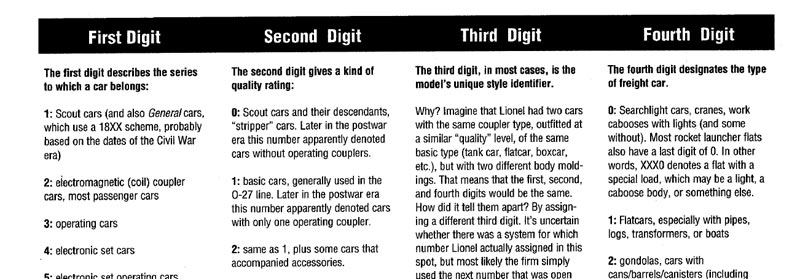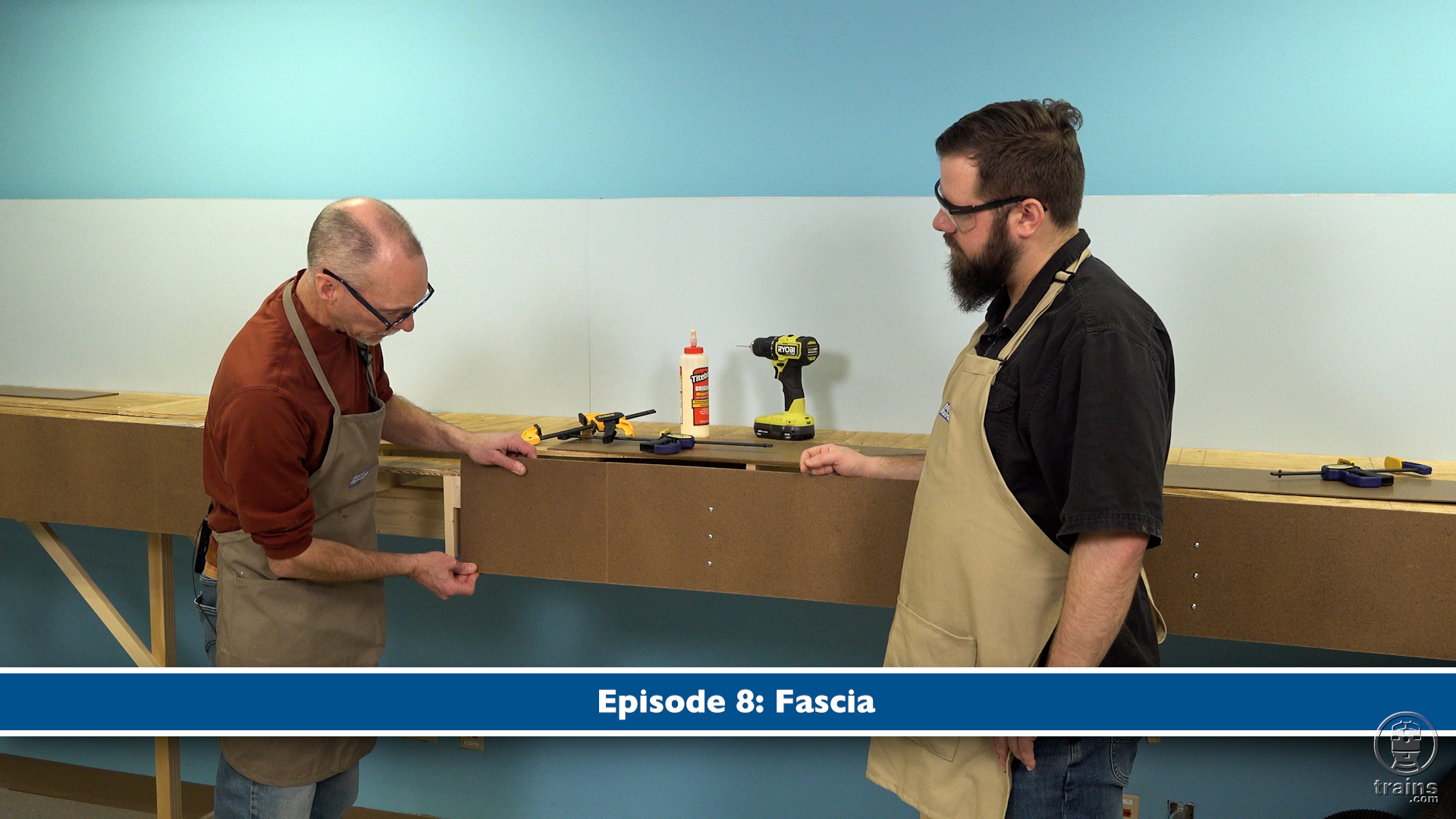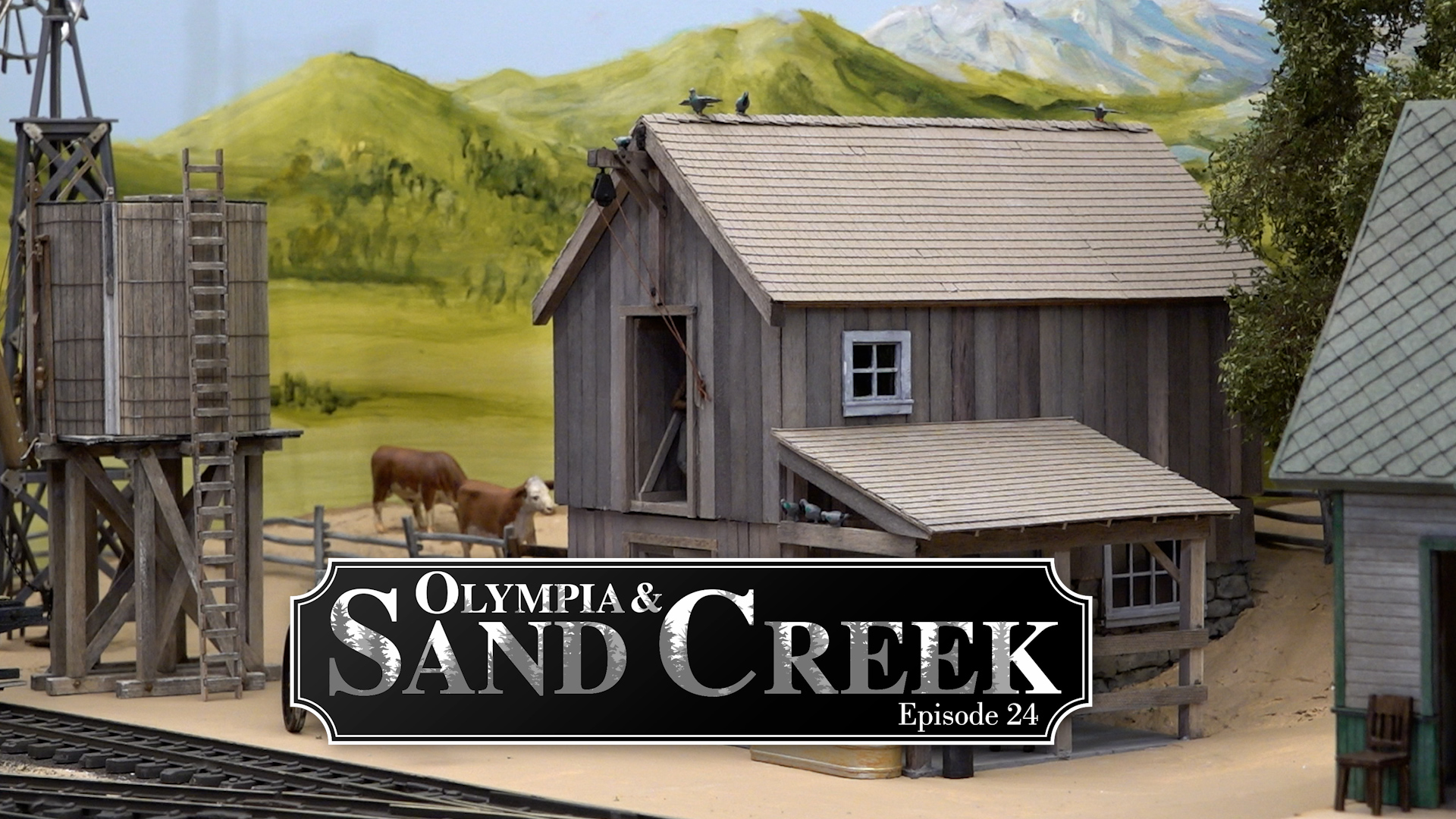The Lionel Corp. used a four-digit number to identify its postwar rolling stock. In some cases cars also carried a one, two, or three-digit suffix. Though many times cars with the same number exhibit slight differences, or variations, Lionel usually assigned a new number if a car received major changes.
While Lionel’s numbering appears haphazard, even random, at first glance, a closer examination suggests that Lionel had a well defined system that it followed for numbering. As you might expect, there are a few exceptions, but the basic system outlined in this article explains the numbers that Lionel selected for virtually all of its postwar rolling stock productions. Cars that are carryovers from the prewar era may vary from this scheme, and so do some late cars that either appeared after the logical numbers had been used or were made for uncataloged sets.
In part, the scheme itself is a carryover from the prewar era. The numbers used to designate car types (see “Fourth Digit” on the PDF chart), in fact, are based on the numbers chosen for the 10-series Standard gauge cars that first appeared in 1906 (in that series, no. 11 was a flatcar, 12 a gondola, 13 a stockcar, 14 a boxcar, 15 a tank car, 16 a hopper, and 17 a caboose).
Why should you care about numbers? Well, let’s say you’re in the market for a gondola, and you’re planning to purchase from an advertisement in CTT or a club publication. If you know how to recognize a gondola car number, and what the different numbers say about the cars, you can scan the ads more quickly and easily.
Understanding the numbering system also gives fans of Lionel’s terrific postwar trains another window into the company that made them. Knowing the logic of the system offers important clues into how Lionel looked at its own products.
THE SYSTEM IN PRACTICE
Let’s consider some examples. Lionel’s long (9 9/16″) gondolas came with sets produced from 1949 to 1969. The first of these models was the 6462. Early 6462s had corner steps, and separate-sale cars and cars included in O gauge sets originally had brake wheels as well. Most 6462s came with six wooden barrels. Both trucks are metal with operating couplers, and all 6462s have a metal underframe.
The number is very logical: first digit 6 (for magnetic coupler), second digit 4 (standard line), third digit 6 (one higher than that of the previous gondola, the shorter 6452), last digit 2 (gondola).
Lionel introduced another gondola in 1956, the 6562. Identical in most respects to the 6462, which by then had lost steps and brake wheels even on O gauge and separate-sale cars, it included four plastic canisters with detailed lettering. The only change was to the second digit, one higher on this upgraded version of the 6462.
Price pressure during the late 1950s led Lionel to introduce a modified long gondola, the 6062, in 1959. Usually unpainted, its trucks were now plastic, it often had only one operating coupler, it had no metal frame, and its load was three plastic cable reels. Loaded with three white unmarked canisters, it bore the number 6162. Lowering the second digit to O and 1 was logical; both cars are clearly inferior in construction to their predecessors.
The 6315, 6415, and 6465 tank cars also illustrate the basic system quite well. The 6315 and 6415 have identical frames and similar levels of detail. It is no surprise, then, that three of the four digits of their numbers are the same. One wonders whether Lionel saw a feature that made the 6415 worthy of the higher second digit – perhaps the three domes, or the fact that it had silver paint and multicolor lettering? More likely, the 6315 had a second digit of 3 simply because it was different from the 6415, but not so different as to change the third digit.
The 6465, still with a first digit of 6, second digit of 4, and last digit of 5, of course formed the core of Lionel’s postwar tanker production. Like the gondolas, the 6465 lost details over the years, including its steps and metal handrails. It remained a 6465 (whether lettered Sunoco, Gulf, Lionel Lines, or Cities Service) even into the 1960s, so long as it kept at least one operating coupler. With fixed couplers (and usually archbar trucks), however, its second digit dropped to 0 and it became a 6045, the next vacant number in the Scout-based tank series (60X5).
Cabooses, too, follow the general pattern. The most common postwar Lionel caboose is the SP-type car, most often numbered 6017 in low-end sets (again, the Scout-based numbering, and with no or only one brake wheel) and 6257 in less expensive O-27 outfits, where it had two brake wheels, at least at first. It was sold as the 6357 in mid-line outfits, featuring two brake wheels plus lights and (after 1952) a smokestack, and as the 6457 in O outfits, where it also included tool boxes, ladders, and two couplers.
The Pennsy N5C-type cabooses, a step up from the SP-type, were numbered 6417/27/37/47, with different third digits but all having the second digit 4. Premium cabooses, such as the 6517 bay-window caboose, the 6557 smoking SP-type, or the 6657 Rio Grande SP-type with its stunning silver-yellow-blue-black paint, have a second digit of 5 or 6 to denote their status.
BEYOND THE BASIC SCHEME
Scout-body cars:
Those O-27 cars which used bodies descended from the Scout line usually carried numbers in sequences made by changing their third digit. For example, the various Scout-body gondolas are al 60X2 (6002, 6012, 6032, 6042, 6062). Likewise, the Scout-body tanks are 60X5 (6015, 6025, 6035, 6045). Scout boxcars are 60X4 (6014, 6024, 6034, 6044), and Scout-style cabooses (SP body, no frills) are 60X7 (6007, 6017, 6027, 6037, 6047, 6057, 6067).
Operating cars:
Operating cars and their non-operating counterparts usually have similar numbers. The classic 3462/72/82 milk car carries the numbers 6472 or 6482 in its non-operating reefer form. If the logical number was not available, though, Lionel chose the next best alternative. It numbered operating versions of the 6464 boxcars 3484 and 3494 because it had used the most logical choices, 3464 and 3474, for earlier operating boxcars. If an operating car and its non-operating counterpart carried different road names, they carried different, but similar, numbers: 6672 Santa Fe reefer and 3662 Lionel Lines milk car, for example.
Some cars took their number from the accessory they accompanied: 3456 hopper (456 coal ramp), 6352 reefer (352 icing station), 6175 rocket flat (175 rocket launcher), 6264 forklift flat (264 forklift platform), 6544 missile car (used the same no. 44 missiles), and the 3460 piggyback car (460 platform). Succeeding piggyback flats had similar numbers: 6430, 6431, 6440. In many cases the car numbers still fit the scheme (6352 is a logical reefer number, 3456 a logical hopper number), though others do not.
Flatcar ranges:
It appears that Lionel assigned vacant numbers within the chronological number series 6400-20, 6500-20, and 6800-30 to flatcars without regard for the last digit. The 6401-09 flatcar series of the early 1960s has a second digit of 4 despite being low-end cars. Was this perhaps because Lionel had already used some numbers in the series 6100-20 for the sheet-metal flats (and sheet-metal frame work cabooses) of the mid-1950s?
Suffixes in practice:
The majority of car types change the third digit to designate different models, for example the 6417, 6427, 6437, and 6447 N5C cabooses. Each model number represents a slightly different combination of features. Different road name cabooses within this series also have different suffixes. A 6427 Virginian is actually a 6427-60; a 6417 Lehigh Valley is actually a 6417-50 (whether painted gray or brown). The 6464-series boxcars likewise used different suffixes for different road names, but since their basic features varied little over the years, the model number did not change.
Hopper anomalies:
In contrast with most other body styles, Lionel numbered its large four-bay hoppers in a series made by changing the second digit: 6436, 6536, 6636, 6737. It’s not clear why Lionel did this rather than add a prefix or suffix, but it’s interesting to note that the company changed the second digit, the quality rating, rather than change the third, the style identifier.
The first large hoppers were the 6436 (LV) and 6446 (N&W, with cover) of 1955. The next year Lionel introduced a silver Alcoa car, also with a cover. The number 6456 was taken (short LV hopper), however, as was 6466 (NYC-style tender, which in effect is another coal car). Lionel dropped the second digit down one, to 6346. Same style car, same third digit, same fourth digit. For later open cars Lionel raised the second digit for each new road name (6356 M&StL, 6636 Alaska, 6736 Detroit & Mackinac).
Form vs. function:
Lionel appears to have considered function as well as form when numbering. It introduced a new, longer, log dump car in 1955, the 3361-55, and later used modified 3361 frames for several additional cars.
The first was the 6362 of 1955, which carried three bar-end trucks. It carries a gondola number, as does the similar (functionally) 6262 wheel car of the next year. Lionel did not actually assign 6361 to a car until 1960, when it introduced the timber transport car.
The 3362 helium tank dump car of 1961, another modified 3361, also uses a gondola number (last digit 2), suggesting that Lionel considered the helium tanks to be barrels or canisters. (Lionel assigned this car the catalog number 3364 when it carried logs, but the car itself always was numbered 3362.)
Most rocket launchers are in the series 66X0, which is logical, since they’re based on flatcars. The exception is the 3349/3309 turbo cars; they have numbers similar to that of the HO item (0349 launcher car) with which they share a launcher.
CONCLUDING THOUGHTS
Finally, the postwar passenger car numbers (excluding prewar carryovers) follow a different, simpler scheme.
Save for the General-type cars, Lionel numbered them in either the 24XX (O-27) or 25XX (O) series. Usually the firm grouped similarly decorated cars in chronological order.
This basic system explains the majority of Lionel’s postwar rolling stock numbers. Adding the “flatcar ranges” noted above and the cars numbered to accompany accessories takes care of most of the remainder. There remain a few exceptions to these rules, but they truly are exceptions. And, even though the system may not be perfect, it gives us enthusiasts another tool that we can use.
Thanks to Steven Serenska, of the REEF Development Corp. (TrainTracker software), for his help in compiling the information for this article. Thanks also to Terral Klaassen and James Sattler for reading and commenting upon preliminary versions of this manuscript.
Curiosities, oddities, and a few mysteries
Even using the rules outlined above, there remain a few cars with numbers that seem odd and even a small number that defy analysis. That’s not to say Lionel didn’t have a reason for the numbers at the time, but some numbers don’t make much sense today.
Were the exploding cars (6470, 6480) numbered with flatcars because the 3470, another target car, was based on a flatcar? Or perhaps because they usually accompanied rocket launchers, most of which have numbers ending in 0? Why wasn’t the similar 6448 fit into the series? Was it numbered as a specialty boxcar, or an accessory car (448 missile set)? The latter seems most likely.
The 6414 auto loader is in a boxcar series. Was it a boxcar in Lionel’s mind, or was there to be an auto accessory? If it’s a boxcar, why not number it 6418, a logical automobile boxcar number? Or was it numbered in the 64XX flatcar series?
It’s more obvious that the 6424 auto car, which shared some of the 6414’s parts, had its number based on the 6414 example, as did the 6416 boat loader. Was the 6418 bridge car intended to carry a bridge other than the one it carried, perhaps a no. 318 or 418 bridge, or was it also simply part of the 64XX flatcar series?
The 3530 Electro-Motive searchlight car probably gained its number because functionally it’s a searchlight car, despite its body type. The 6530 fire car has a number similar to the 3530 searchlight car because they share a body. Form over function? How about the 6050 bank cars, which are boxcars by body style, but flats by number? Perhaps Lionel numbered them as such because they carry a load, perhaps because the logical boxcar number was already assigned.
Some operating cars appear arbitrarily placed within operating number series (34XX, 35XX), for example the 3535 security car, 3540 radar car, and 3545 TV car. Others have numbers that appear to have been roughly based on the numbers of other cars with which they share parts, such as the 3665/6 Minuteman-based launchers (6650 rocket launcher) and 3512 fire car (52 motorized unit). The 6512 cherry picker car, very similar to the 3512, then took its number from the 3512.
The 6822 searchlight doesn’t have a number that ends in 0 like the other searchlight cars, though it does fit in the 68XX flatcar series. The 638-2361 boxcar uses the telephone number of its sponsor, Stokely Van Camp’s. The 3444 animated gondola is a gondola by body, but similar to 3424 boxcar in action, since it also has a moving figure. Was that the basis for its number? A few cars wound up in sequence but out of their type, for example the 6057, 6058, and 6059 cabooses.
Some numbers were used twice, including 6440, used for a postwar metal passenger car and a flatcar, and 216 and 221, used for multiple Alco diesels.
Finally, a few mystery cars remain: the 3357 cop and hobo car, the 3370 sheriff and outlaw car, the 6467/6477 bulkhead cars, and the 3927 track cleaner. Three of these four have a fourth digit that denotes a caboose. Why? If any reader has an explanation for these numbers, or information to add to this article, we’d love to hear from you. – Terry Thompson














